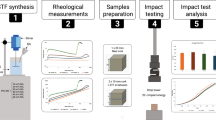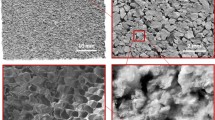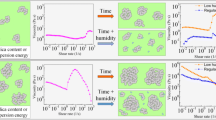Abstract
Shear thickening fluid (STF) is a very interesting and promising material in several application fields where a different mechanical is demanded based on loading rates, like body armor and vibration insulators. Cork is a natural cellular material by excellence, filled with well-known beneficial effects in terms of insulation and also interesting crashworthiness properties. In this work, cork grains of very small size (0.5–1.0 mm) are added to two different shear thickening suspensions, one of them a fully natural water and cornstarch, and the other based on fumed silica and polyethylene glycol. The rheology of these eco-friendly suspensions was investigated and the influences of including cork grains were discussed. In addition, microscopic analyses were carried out to observe the deformations at each component during the shear thickening phenomenon. Cork grains reduce the load-carrying capacity in the suspensions due to the deformable characteristics of cork. For this reason, shear thickening properties are suppressed in the mixtures. Despite this, it is possible to state that viscosity increase in the mixtures leads to strong particle contacts, and thereby resulting in particle deformations in the main constituent powder as well as in the cork additives due to their softer structures.








Similar content being viewed by others
References
Cwalina CD, Dombrowski RD, McCutcheon CJ, Christiansen EL, Wagner NJ. MMOD puncture resistance of EVA suits with shear thickening fluid (STF)—armortm absorber layers. Procedia Eng. 2015;103:97–104. https://doi.org/10.1016/j.proeng.2015.04.014.
Gürgen S. An investigation on composite laminates including shear thickening fluid under stab condition. J Compos Mater. 2019;53(8):1111–22. https://doi.org/10.1177/0021998318796158.
Gürgen S, Kuşhan MC. The stab resistance of fabrics impregnated with shear thickening fluids including various particle size of additives. Compos Part Appl Sci Manuf. 2017;94:50–60. https://doi.org/10.1016/j.compositesa.2016.12.019.
Gürgen S, Kuşhan MC. The effect of silicon carbide additives on the stab resistance of shear thickening fluid treated fabrics. Mech Adv Mater Struct. 2017;24(16):1381–90. https://doi.org/10.1080/15376494.2016.1231355.
Xu Y, Chen X, Wang Y, Yuan Z. Stabbing resistance of body armour panels impregnated with shear thickening fluid. Compos Struct. 2017;163:465–73. https://doi.org/10.1016/j.compstruct.2016.12.056.
Majumdar A, Butola BS, Srivastava A. Development of soft composite materials with improved impact resistance using Kevlar fabric and nano-silica based shear thickening fluid. Mater Des 1980–2015. 2014;54:295–300. https://doi.org/10.1016/j.matdes.2013.07.086.
Gürgen S, Kuşhan MC. The ballistic performance of aramid based fabrics impregnated with multi-phase shear thickening fluids. Polym Test. 2017;64:296–306. https://doi.org/10.1016/j.polymertesting.2017.11.003.
Wei M, Lin K, Guo Q. Modeling mechanical properties of a shear thickening fluid damper based on phase transition theory. EPL Europhys Lett. 2018;121(5):50001. https://doi.org/10.1209/0295-5075/121/50001.
Zhang XZ, Li WH, Gong XL. The rheology of shear thickening fluid (STF) and the dynamic performance of an STF-filled damper. Smart Mater Struct. 2008;17(3):035027. https://doi.org/10.1088/0964-1726/17/3/035027.
Zhou H, Yan L, Jiang W, Xuan S, Gong X. Shear thickening fluid–based energy-free damper: design and dynamic characteristics. J Intell Mater Syst Struct. 2016;27(2):208–20. https://doi.org/10.1177/1045389X14563869.
Gürgen S, Kuşhan MC, Li W. Shear thickening fluids in protective applications: a review. Prog Polym Sci. 2017;75:48–72. https://doi.org/10.1016/j.progpolymsci.2017.07.003.
Wei M, Hu G, Jin L, Lin K, Zou D. Forced vibration of a shear thickening fluid sandwich beam. Smart Mater Struct. 2016;25(5):055041. https://doi.org/10.1088/0964-1726/25/5/055041.
Gürgen S, Sofuoğlu MA. Experimental investigation on vibration characteristics of shear thickening fluid filled CFRP tubes. Compos Struct. 2019;226:111236. https://doi.org/10.1016/j.compstruct.2019.111236.
Gürgen S, Sofuoğlu MA. Vibration attenuation of sandwich structures filled with shear thickening fluids. Compos Part B Eng. 2020;186:107831. https://doi.org/10.1016/j.compositesb.2020.107831.
Gürgen S, Sofuoğlu MA. Integration of shear thickening fluid into cutting tools for improved turning operations. J Manuf Process. 2020;56:1146–54. https://doi.org/10.1016/j.jmapro.2020.06.012.
Span J, Koshy P, Klocke F, Müller S, Coelho R. Dynamic jamming in dense suspensions: surface finishing and edge honing applications. CIRP Ann. 2017;66(1):321–4. https://doi.org/10.1016/j.cirp.2017.04.082.
Li M, Lyu B, Yuan J, Yao W, Zhou F, Zhong M. Evolution and equivalent control law of surface roughness in shear-thickening polishing. Int J Mach Tools Manuf. 2016;108:113–26. https://doi.org/10.1016/j.ijmachtools.2016.06.007.
Li M, Lyu B, Yuan J, Dong C, Dai W. Shear-thickening polishing method. Int J Mach Tools Manuf. 2015;94:88–99. https://doi.org/10.1016/j.ijmachtools.2015.04.010.
Gürgen S, Sert A. Polishing operation of a steel bar in a shear thickening fluid medium. Compos Part B Eng. 2019;175:107127. https://doi.org/10.1016/j.compositesb.2019.107127.
Gürgen S, Li W, Kuşhan MC. The rheology of shear thickening fluids with various ceramic particle additives. Mater Des. 2016;104:312–9. https://doi.org/10.1016/j.matdes.2016.05.055.
Gürgen S, Kuşhan MC, Li W. The effect of carbide particle additives on rheology of shear thickening fluids. Korea–Aust Rheol J. 2016;28(2):121–8. https://doi.org/10.1007/s13367-016-0011-x.
Gürgen S. Tuning the rheology of nano-sized silica suspensions with silicon nitride particles. J Nano Res. 2019;56:63–70. https://doi.org/10.4028/www.scientific.net/JNanoR.56.63.
Gürgen S, Sofuoğlu MA, Kuşhan MC. Rheological compatibility of multi-phase shear thickening fluid with a phenomenological model. Smart Mater Struct. 2019;28(3):035027. https://doi.org/10.1088/1361-665X/ab018c.
Laha A, Majumdar A. Shear thickening fluids using silica-halloysite nanotubes to improve the impact resistance of p-aramid fabrics. Appl Clay Sci. 2016;132–133:468–74. https://doi.org/10.1016/j.clay.2016.07.017.
Hasanzadeh M, Mottaghitalab V. Tuning of the rheological properties of concentrated silica suspensions using carbon nanotubes. Rheol Acta. 2016;55(9):759–66. https://doi.org/10.1007/s00397-016-0950-7.
Sha X, Yu K, Cao H, Qian K. Shear thickening behavior of nanoparticle suspensions with carbon nanofillers. J Nanoparticle Res. 2013;15(7):1816. https://doi.org/10.1007/s11051-013-1816-x.
Gil L. New Cork-based materials and applications. Materials. 2015;8(2):625–37. https://doi.org/10.3390/ma8020625.
Fernandes F, Alves de Sousa R, Ptak M, Migueis G. Helmet design based on the optimization of biocomposite energy-absorbing liners under multi-impact loading. Appl Sci. 2019;9(4):735. https://doi.org/10.3390/app9040735.
Santos PT, Pinto S, Marques PAAP, Pereira AB, Alves de Sousa RJ. Agglomerated cork: a way to tailor its mechanical properties. Compos Struct. 2017;178:277–87. https://doi.org/10.1016/j.compstruct.2017.07.035.
Kaczyński P, Ptak M, Fernandes FAO, Chybowski L, Wilhelm J, Alves de Sousa RJ. Development and testing of advanced Cork composite sandwiches for energy-absorbing structures. Materials. 2019;12(5):697. https://doi.org/10.3390/ma12050697.
Amorim Cork Composites. https://www.amorimcork.com/en/natural-cork/cork-and-other-applications/. Accessed 09 May 2019.
D. Kukich. Put a cork in it: Research details quiet composite material. ScienceDaily. https://www.sciencedaily.com/releases/2012/06/120622162946.htm. Accessed 08 Sept 2020.
Mari R, Seto R, Morris JF, Denn MM. Discontinuous shear thickening in Brownian suspensions by dynamic simulation. Proc Natl Acad Sci. 2015;112(50):15326–30. https://doi.org/10.1073/pnas.1515477112.
Pednekar S, Chun J, Morris JF. Simulation of shear thickening in attractive colloidal suspensions. Soft Matter. 2017;13(9):1773–9. https://doi.org/10.1039/C6SM02553F.
Anjos O, Pereira H, Rosa ME. Effect of quality, porosity and density on the compression properties of cork. Holz Als Roh-Werkst. 2008;66(4):295–301. https://doi.org/10.1007/s00107-008-0248-2.
Pharr GM. Measurement of mechanical properties by ultra-low load indentation. Mater Sci Eng A. 1998;253(1–2):151–9. https://doi.org/10.1016/S0921-5093(98)00724-2.
Acknowledgements
The authors gratefully acknowledge the grants; UID/EMS/00481/2019-FCT and CENTRO-01-0145-FEDER-022083—Centro2020, European Regional Development Fund (ERDF).
Author information
Authors and Affiliations
Corresponding author
Ethics declarations
Conflict of interest
The authors declare that they have no conflict of interest.
Ethical approval
This manuscript does not contain any studies with human participants or animals performed by any of the authors.
Additional information
Publisher's Note
Springer Nature remains neutral with regard to jurisdictional claims in published maps and institutional affiliations.
Rights and permissions
About this article
Cite this article
Gürgen, S., de Sousa, R.J.A. Rheological and deformation behavior of natural smart suspensions exhibiting shear thickening properties. Archiv.Civ.Mech.Eng 20, 110 (2020). https://doi.org/10.1007/s43452-020-00111-4
Received:
Revised:
Accepted:
Published:
DOI: https://doi.org/10.1007/s43452-020-00111-4




